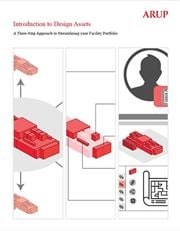Many large companies rely on a portfolio of functional built assets. Data centres, fulfilment centres, logistics hubs, storage facilities – these and other types of facilities must be delivered quickly and designed to produce consistent performance. This is hard, requiring organisations to break down existing silos, manage information strategically, define the optimal design for facilities, and make decisions that are informed by data across their portfolio.
We help companies to adopt an efficient, mass-production ethos to the design, production and maintenance of these portfolios of built assets, by replicating a design to achieve better return on investment and economies of scale. Specific facility designs are prototyped and are used to drive standardisation across geographic regions. The benefits are:
accelerated speed-to-market of new building facilities
improved consistency across their portfolio
enhanced quality control
reduced risk in building asset delivery
improved cost efficiency
data-driven, portfolio-wide operational and commercial insights
Achieving uniformity
Achieving uniformity is both an appealing goal and a complex challenge. Standardised facility designs can be quickly undone by variations across project sites due to availability of materials or equipment, nuanced local building codes, local climate factors or disparities in site design requirements. Organizations also struggle to enforce the proper use of the right versions of equipment, design standards or technical specifications. As the prototype evolves, the various project teams must keep up.
There are also a variety of different procurement and construction methods to consider. If speed-to-market is a priority, for example, a range of modular strategies can be examined to find the best balance between shop assembly and site construction. And digital tools that enable the early selection of long-lead systems can help remove them from the schedule’s critical path.
A design asset standardisation service
We have developed a service and supporting digital tools that are designed to achieve this level of standardisation and efficiency. First, we help clients develop an organisational strategy for standardisation that works for them. Our specialist digital consultant teams then help our clients in the delivery of digital tools and information management strategies to help large organisations remain coordinated across stakeholder groups, respond to local variability with standardised solutions, adapt to evolving technologies and facility designs, and make decisions informed by portfolio-wide data that is easier to access and understand.
Of course, process enhancement within a large organisation can be a significant undertaking. That’s why we have developed a three-stage process for organisational change management that offers significant incremental improvement over time.
Our method
Design Asset Management - mass production at scale
This three-stage process enables a large organisation to adopt a mass-production approach to their portfolio of built assets. Facility reference designs become repeatable modular components, enabling even greater future flexibility of use. Individual site designs can be adapted to local needs while maintaining conformity with standardised guidelines developed to minimise risk, maximise delivery speed and yield optimal asset performance.
Clients gain the ability to treat this vital part of their property portfolio as reusable design assets for the first time – benefitting from greater insights and cost savings as a result.

 ;
;


